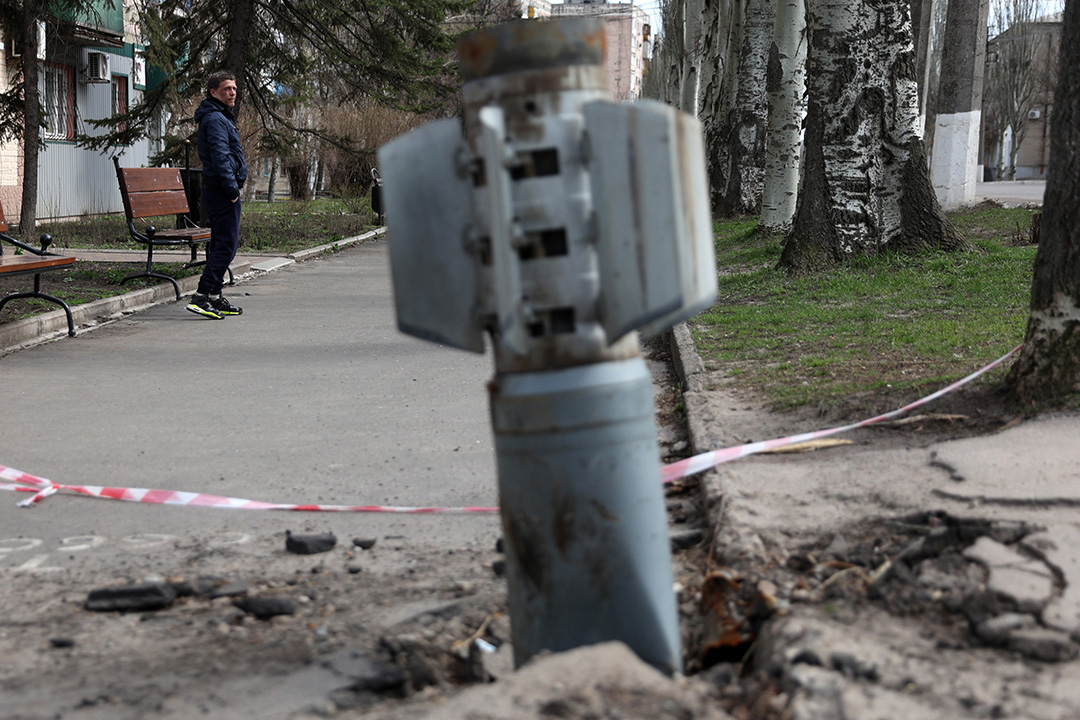The US recently agreed to provide Ukraine with cluster munitions as part of an $800 million security package, despite the controversial weapon being banned by over 100 countries including key Nato allies. The argument stated was that Ukrainian forces have struggled to make major gains in their counter-offensive against Russia.
As the war evolves, the US is providing Ukraine with other munitions that are important for its military effort to repel Russia’s forces, including regular 155mm munitions and a new type of 155mm artillery shell that can hit targets with greater precision. What makes the US decision more puzzling is that most countries have agreed that cluster munitions should have no place in modern warfare.

A man walks past an unexploded tail section of a 300mm rocket which appears to contain cluster bombs, launched from a BM-30 Smerch multiple rocket launcher, embedded in the ground after shelling in Lysychansk, Lugansk region on April 11, 2022. Photo: Anatolii STEPANOV/ AFP
The Cluster Munition Coalition (CMC) has expressed that it is appalled by the US decision. The transfer of cluster munitions is prohibited under the 2008 Convention on Cluster Munitions.
Russia’s extensive use of cluster munitions has caused civilian harm, damage to civilian infrastructure and contamination of agricultural land. Ukrainian forces have used cluster munitions to a lesser degree.
What are cluster munitions?
What is it about cluster munitions that have caused several humanitarian organisations to criticise the US decision? Cluster munitions are not a new weapon used in warfare. It was first used during World War II and involves a class of weapons including rockets, bombs, missiles and artillery projectiles. These projectiles break apart mid-air and scatter smaller munitions over a large area. The wide area effects of these weapons and the large numbers of submunitions that fail to explode as intended have caused large numbers of civilian casualties.
The main problem with cluster munitions’ bomblets is a design flaw, as they should explode or ignite upon hitting the ground, but this has proven not to be the case with their failure rate being the highest among all classes of weapons, with lasting and often devastating consequences for civilians.
Even with technological advances, cluster munitions have not provided an adequate solution as some have argued. This has led to a growing number of States joining the Convention on Cluster Munitions to tackle the humanitarian problems caused by this weapon.
Why are cluster munitions of such concern from a humanitarian perspective?
According to the International Committee of the Red Cross, with large numbers of submunitions failing to explode on impact, the ICRC lists the following as important humanitarian concerns:
- Credible estimates of the failure rates of these weapons in recent conflicts have varied from 10% to 40%. Large-scale use of these weapons has resulted in countries and regions being infested with tens of thousands, and sometimes millions, of unexploded and highly unstable submunitions.
- Unexploded submunitions often explode when handled or disturbed, posing a serious danger to civilians. The presence of these weapons poses a threat to displaced civilians returning to their homes, obstructs relief and reconstruction efforts and makes vital subsistence activities like farming hazardous for years or even decades after the conflict has ended.
- Because they are wide-area weapons that can release vast numbers of sub-munitions over an area of up to tens of thousands of square metres, the impact of cluster munitions on civilians during conflicts is also a serious concern, in particular when they are used in populated areas.
- As most submunitions are not precision-guided, their accuracy can be affected by weather and other environmental factors. They may therefore hit areas outside the military objective targeted. When such weapons are used in or near populated areas, they can pose a significant danger to civilians both during the attack and in the immediate post-strike period when people resume their normal activities.
According to reports, the US intends to send Ukraine 155mm artillery shells loaded with explosive grenades called dual-purpose improved conventional munitions (DPICMs). As cluster munitions disperse hundreds or even thousands of tiny but deadly bomblets, over an area to attack both armoured vehicles as well as dismounted troops, their use also produces significant quantities of unexploded submunitions that can maim, injure or kill civilians and friendly forces during, and long after a conflict.
The US stockpile includes DPICMs, surface-to-surface warheads, and other types of cluster munitions. The two main 155mm DPICM shells in the US inventory are the M483, which contains 88 grenades, and the longer-range M864 which carries 72 grenades. It is still unclear which version will be delivered.
Both shells use the same kinds of DPICM grenades, which often fail to immediately explode due to environmental factors, such as landing in vegetation or on soft ground. The grenades lack the ability to self-destruct, and often remain hazardous for decades capable of exploding if mishandled due to their particularly sensitive fuses.
Because of the high potential latent risks, 123 countries have signed the 2008 treaty, which prohibits state parties from developing, producing, acquiring, using, transferring or stockpiling cluster munitions — 23 Nato members are parties to the treaty, the US, Ukraine and Russia are not.
Will cluster munitions be the magic bullet for the Ukraine war effort?
Security analysts are divided as providing it will not guarantee a “winning weapon” in Ukraine’s war effort. The country’s ongoing counteroffensive will not achieve success based on the delivery of any one specific weapon.
On the battlefield, cluster munitions cannot distinguish between a Russian soldier and a Ukrainian soldier. Resulting in placing advancing forces (and civilians) at risk of encountering unexploded ordnance from earlier bombardments. The limited military utility and the substantial humanitarian dangers of these weapons are among the key reasons why they should not be used.
Jens Stoltenberg, Nato’s secretary general, has stressed that the military alliance does not have a formal position on the use of cluster munitions so any decision to use the weapons would be at the discretion of member states. Most Nato member states are signatories to the treaty. Currently, more than two-thirds of all Nato members — including the UK, France, Germany and Spain — do not support providing cluster munitions to Ukraine due to the humanitarian risks posed by these weapons. The Convention on Cluster Munitions also limits the ability of nations that are signatories to cooperate militarily with countries that employ them.
In short, sending cluster munitions to Ukraine may result in the US ceding the moral high ground that has been crucial for sustaining support for Ukraine’s effort to defend itself. Moscow, which has already used cluster munitions, may attempt to negatively frame the US decision to supply these weapons to sow doubt concerning Ukraine’s cause among non-aligned countries.
Instead of focusing on answering calls for banned cluster munitions, efforts should instead be spent on providing Ukraine with precision-guided munitions. As the war drags on, security analysts agree the Ukrainian forces have consistently surpassed battlefield expectations and done so without the widespread use of cluster munitions.
“It must be remembered, the whole point of outlawing a certain weapon type is to outlaw it; it is not to selectively say we are against it unless an army we support wants to use it.”
This article appeared first in Mail & Guardian on 13 July 2023.
Craig Moffat, PhD is the Head of Programme: Governance Delivery and Impact for Good Governance Africa. He has more than 17 years of practical experience working for government institutions and multilateral organisations. He was previously employed by the South African Foreign Service, where he worked extensively at identifying and analysing security threats towards South Africa as well as the southern Africa region. Previously, he was the political advisor for the Pretoria Regional Delegation of the International Committee of the Red Cross. He holds a PhD in Political Science from Stellenbosch University.












